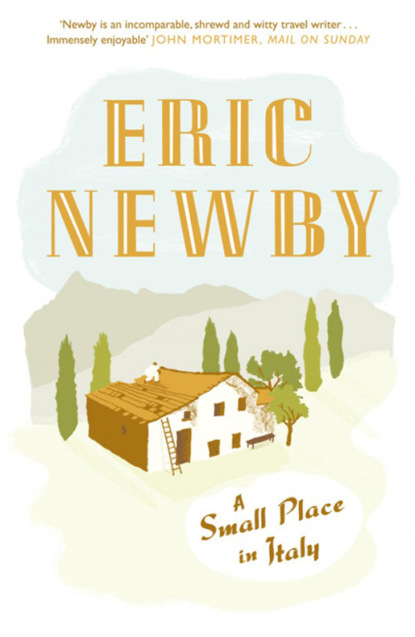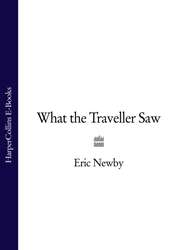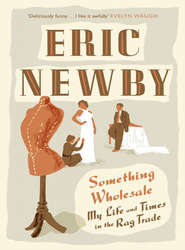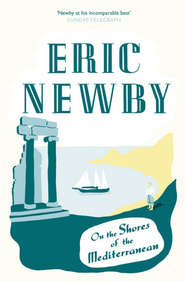По всем вопросам обращайтесь на: info@litportal.ru
(©) 2003-2024.
✖
A Small Place in Italy
Автор
Год написания книги
2018
Настройки чтения
Размер шрифта
Высота строк
Поля
To do this we would have to go to Monfalcone, near Trieste, where Wanda’s mother’s notary carried on his business and would do what was necessary.
We took a night train to Monfalcone, got the document, spent the next night with Wanda’s mother, got the money in cash and returned to find that Signor Vescovo had already come up with the money and handed it over to Signor Botti.
Now, apart from a few formalities, we were the owners of a small place in Italy called I Castagni.
SIX (#ulink_2b5b9c95-3995-51bb-aac6-c9ca006b4a63)
The winter that followed our acquisition of I Castagni was a bitter one. Our house, which was near Wimbledon Common, was colder than most, due to the fact that we hadn’t been able to afford to have central heating installed. All our resources had been consumed in stemming a disastrous outbreak of dry rot which had necessitated the removal of the entire façade of the building, so that while repairs were being carried out, looking at it from outside, having lifted the tarpaulin which covered it, was like peering into a doll’s house.
Sometimes, when working at home on some piece for the Observer with a title such as ‘The Best Bistros in Martinique’, written by someone I had commissioned who complained of the heat in the Caribbean, to restore my circulation, long before jogging was invented, I used to go running on Wimbledon Common and across Richmond Park.
There, while pounding up the long snowy rides in the dusk, between the giant oaks that had been planted centuries ago, with the rooks like black rags scattering on the wind high above them, I thought of the little house in Italy, as full of holes as the sieve in which the Jumblies put to sea, and Attilio, its diminutive occupant, and wondered if they were both still standing. The house was not even insured. In the excitement we had forgotten to insure it. Should we now be thinking of insuring Attilio, in case the house collapsed on top of him?
One thing was certain: no one except Signor Vescovo, and he had his own troubles what with his ristorante and his produzione propria, or our friend Valeria at Tellaro would think of letting us know if anything untoward happened.
The only other persons even faintly interested would be Signora Angiolina and Attilio and all that one was likely to get out of him would be a series of ‘Heh! Heh! Heh!’ noises, which was what it sounded like when he went through the motions of chuckling to himself, while Signora Angiolina’s contribution would probably be a ‘Ma!’
All we could do now was to wait until the following Easter when, all being well, I would be able to have some more time off in which we could take possession of our newly acquired property. It was fortunate that by this time our children were sufficiently grown up to be at universities and no longer reliant on us for amusement during the holidays.
Easter Sunday fell almost as late as it possibly could, and when we set off for Italy on the Tuesday of Easter week, it was in a Land Rover crammed with everything we could think of that might help us to survive in what was little more than the shell of a house.
All the way across France and northern Italy it poured and poured, except at the Mont Blanc Tunnel where it was snowing at both ends, as it had been the previous time. As Wanda said, ‘When it comes to travelling we are some pickers!’
We eventually reached the eighteenth, twenty-first or twenty-second bend, or whatever it was, in the early afternoon of Good Friday, Venerdì Santo. The weather was much too bad to attempt to open up the house and we decided to stay the night in a hotel up at Fosdinovo. We had had enough of camping.
So we continued on up another lot of bends until we reached the town of Fosdinovo, which up to now we had not seen except once in passing through it, and there we put up at one of the two hotels.
The town was situated on a steep-sided spur, more than 500 metres above the sea, and much of it was almost completely hidden from view behind its mediaeval walls and ramparts. The hotel we had chosen to stay in stood just outside the lower of the two principal gates. To the east and west the ramparts terminated in a series of precipices, falling away on the eastern side to dense forests. To the west they fell, equally steeply, to the same sort of terraced hill country in which I Castagni was situated. Through it ran a deep gorge, carved out by a torrent that had its origin higher up the mountainside, and eventually emptied itself, that is when there was any water to empty, into the Magra near Sarzana. All in all, Fosdinovo would have been a difficult place for a besieging army to take. The only possible way would have been to attack it from the top of the spur but this was effectively defended by the vast Castello Malaspina.
The Castello was an ideal residence for the Malaspina who spent much of the time over many centuries, in common with other members of the local aristocracy, plotting. From the fourteenth century onwards, they were a power in the region, reinforced by judicious couplings with such famous families as the Gambacorti of Pisa, the Doria, the Centurione, the Pallavicini of Genoa, the Orsucci of Lucca, the Santelli of Pesaro and the Cangrande della Scala, a union recorded by a marble relief over the entrance to the Castello, depicting a dog with a flowering hawthorn in its mouth. And they remained a power until 1796 when Carlo Emanuele Malaspina was deprived of his domains by the French.
The hotel was of a sort that had already long since become a rarity in most parts of Italy, even the most remote, and although we neither of us knew it at the time, its days in its present form were numbered.
Old, if not ancient, dark, cavernous, rambling were just some of the epithets that could be applied to it without being offensive. In fact it was lovely. Its rooms were full of good rustic furniture of the mid-nineteenth century and of later date, of a sort that we would have been only too happy to acquire for I Castagni: presses and chests-of-drawers in mahogany and chestnut which could swallow up heaps of clothes; cylindrical marble-topped bedside tables of the sort that Attilio possessed which also secreted within them massive vasi da notte with floral embellishments, receptacles of which, judging by the sanitary arrangements obtaining at I Castagni, we were going to stand in constant need.
But most desirable of all were the beautiful bedsteads, of all shapes and sizes, built of wood or wrought iron with tin-plate panels painted with flowers and arcadian landscapes, or decorated with mother-of-pearl, or very simple ones constructed entirely of wrought iron with no embellishment at all.
The hotel was owned by a local butcher who had a shop a few yards up the road, inside what had been one of the gates of the town. He also made excellent salami. He was a good butcher, but he always gave the impression of being on the point of falling asleep, like the Dormouse in Alice in Wonderland. Even shaking hands with him was an enervating experience.
His wife was of an entirely different disposition: large but not fat, black-haired, full of energy, what the Italians call slancio, and with a voice that made the rafters ring, and she was as adept at cutting meat or boning hams as her husband.
She was also extremely generous. The morning of Easter Saturday when we left the hotel to go down to I Castagni and paid our bill she gave us an entire salame as if it were an arrival present, and whenever thereafter we bought anything in the shop and she was there she always gave us something extra, which meant that we couldn’t use it as much as we might otherwise have done.
There were two daughters of marriageable age, both of whom had fiancés. They were personable girls and were a good catch for any young men, with an hotel, a ristorante, a caffè/bar and butcher’s shop as visible future assets. Meanwhile they acted as waitresses and chambermaids and ran the bar, all of which was enough to be getting on with, while the Signora’s elderly mother did the cooking for the ristorante with some outside help in the season, which had not yet begun. Both subsequently married.
After we had signed in and had been consigned to one of the cavernous bedrooms which by now, with the awful weather prevailing outside, was almost totally dark, the two girls invited us to take part in the Processione del Venerdì Santo.
This procession, which had to end in the afternoon, at the hour of Christ’s death, was due to start in a couple of minutes from the Oratorio dei Bianchi, an old church in the middle of the town. In the course of this procession the participants would make an almost complete tour of it. They themselves were going to take part. Would we like to go with them? We said yes.
Swathed in the warmest clothes we had at our disposal, but still inadequately clad – the wind was coming straight off the Apuan Alps, which were newly snow-covered – we set off with the girls for the piazza in which the Oratorio was situated and in which the procession would be assembling.
The piazza was about the size of a squash court and one side of it was entirely taken up by one façade of the Oratorio, an austere and beautiful construction of what appeared to be almost translucent marble. It had been built in 1600 by Pasquale Malaspina and a great marble escutcheon over the entrance displayed the coat of arms of the Malaspina, a flowering hawthorn. Below it there was an Annunciation carved in the same material. Inside the building, hidden behind the high altar, was a wooden statue of the Madonna, carved in 1300 and lodged here when the church was built, after the original one was destroyed by fire.
Normally the doors of the Oratorio were kept closed but this afternoon they were wide open to allow an effigy of the Crucified Christ to be taken out from it into the piazza on a wooden float carried by a band of porters, who supported the weight on their shoulders. Two other men also emerged from it bearing a funereal-looking black and silver banner which was now giving trouble in the wind that was swirling around the piazza.
At the head of the procession was the rather elderly priest of Fosdinovo and Caniparola, dressed in black vestments. He was accompanied by a couple of acolytes, who were without their censers, because they were not used in such processions, and a good thing too, in the wind that was blowing, they might easily have set themselves on fire, or some other participant.
They were followed by the main body of the faithful, among whom we found ourselves. Altogether there were not many more than fifty people and most of them were women. There were also a few children; but it was not surprising that there was a poor turn-out. It was terrible weather for a procession. Already at around two in the afternoon it was growing dark.
Conspicuous among the few men present in the piazza, apart from those who would be carrying the images, looking benevolently at all and sundry, was Attilio who, we later learned, was not only molto religioso but also a grande appassionato of religious feasts and processions. He had walked up from I Castagni in the appalling weather in order to attend this one and, in spite of the buffeting he must have received on the way, was very smart in a long, dark navy-blue, fur-collared overcoat of antique cut which almost reached to his ankles, and an article of clothing without which neither of us saw him, except when, later on, he had to go to hospital, his cap.
As soon as he saw us he came shooting across the piazza as if it was ice – in fact it was wet marble and equally slippery. Then, after paying his respects to the girls in a formal manner, he took our hands in his, first Wanda’s, then mine, and pumped them up and down as if he expected water to come gushing out of our mouths, at the same time saying, so far as either of us could understand, how happy he was to see us.
But what was more extraordinary, so far as I was concerned, was that, when he began the pumping treatment he said, perfectly audibly, after having more or less cut me dead up to now, ‘Adesso ricordo!’ (‘Now I remember!’)
What he said was mysterious, if not ambiguous. Unless I knew, which I now did without a shadow of doubt, that he, Attilio, and the old man in the mountains of twenty-odd years ago were not one and the same, I would have thought that when he said, ‘Adesso ricordo!’ he was remembering that time, whereas what he was presumably referring to was our brief encounter five months ago. I gave up. Two storytellers, both of whom could make things, both of whom were religioso, one of whom, possibly both of whom prayed by their bedsides, although there must be, I realized, whole hordes of little old men in Italy who do just that, were more than I could cope with. Eventually the whole thing was resolved when I asked Signora Angiolina if Attilio had ever gone away from home during the war. She said categorically no, he hadn’t. I was sorry I asked. Perhaps it would have been better if it had remained a mystery but short of having a sphinx on the premises at I Castagni I could hardly complain.
Anyway I didn’t care. What he had just said to me gave me the same feelings of pleasure that I would experience in the future when Signora Angiolina said to me ‘Hai fatto bene!’ To be remembered by Attilio was different from being remembered by any Tom, Dick or Harry, or even General de Gaulle. He never enlarged on what he meant again. Now, however, to show where his sympathies lay, he attached himself, as it were, to our suite and prepared to walk with us in the procession.
It was at this moment that the priest gave some kind of inconspicuous signal, but one that was sufficient to set the whole thing in motion, and we all began to move uphill with the priest in the van, flanked by the acolytes, followed by Christ nailed to the Cross and the two men carrying the black and silver banner flapping madly in the wind, and behind them the main body of whom I was certainly the only Protestant present, snuffling and sneezing, for a number of them had already contracted nasty colds, sometimes chanting, sometimes reciting the rosary or saying various Lenten prayers, but somehow contriving not to do all these at the same time, which would have resulted in pandemonium.
The priest, although he looked rather old, was fearfully fit. He led us at what amounted to a trot into the teeth of the freezing wind and zoomed us through the winding streets and alleys, flanked by secretive-looking houses that made up Fosdinovo, mediaeval streets and alleys in which, this Friday afternoon, almost every house had at least one window with a candle burning in it, to welcome the procession.
Some windows were draped in funereal Lenten black, others were less lugubrious with white lace curtains and some were positively jolly with flowers displayed in them. We passed an ancient Malaspina theatre that was no longer a theatre and a Malaspina Mint that was no longer a mint. It only minted fifty genuine coins in its entire history. The rest, which were exported to Genova and France, were all false.
And there were shops, some of them minute, also illuminated with candles. Shops that sold wine, spades, handsaws and other ironware, hand-knitted socks with the natural grease still in them, and magazines giving the latest low-down on what was currently going on with the Grimaldis in the Principality of Monaco, events on which all Italy was hooked.
And we passed a caffè from the windows of which some of the male occupants looked out on the procession with the curious, slightly derisory air with which men in Italy look out of the windows of caffès at religious processions. That is if they are agnostic, communist, or simply not taking part in the procession for their own private reasons, keeping, as it were, their cards close to their chests.
That is also if they hadn’t got wives or mothers or grandmothers taking part in these processions. If they had, and if they had any sense and wanted a quiet life, they would keep a much lower profile and get on with watching TV, or playing briscola, a sort of whist, and not start looking out of the window with that superior expression on their faces.
By now the wind was tremendous. At one point we came out on some ramparts below the Castello and there a savage blast caught the crucifix, bringing the bearers to their knees and almost throwing it the ground, which would have been a malaugurio – and forcing the men carrying the banner to furl it.
Now we were rounding the foot of the keep of the Castello, a huge fortress in which Dante had been put up in 1306, while he wrote some stanzas of the Inferno, as he had apparently been, that same year, in the castle at Castelnuovo di Magra, the one we had seen the first time we had driven up the road from Caniparola, before making one of his mysterious disappearances from circulation. And as we were following this trench-like alley which ran between the dwellings and the walls, we could see the castle domestics looking down on us from overhead.
From now on most of the processional route was downhill. The first and last stop was at the Church of San Remigio in the middle of the town, the principal church of Fosdinovo.
Here the Crucified Christ was taken in, together with the now unfurled banner and followed by the rest of us, for the Adoration of the Cross.
Now the priest sang Ecce Lignum Crucis (Behold the Wood of the Cross), removed his shoes and adored it, prostrating himself three times and finally bending down and kissing the feet on the crucifix. Immediately after this the rest of the congregation went up to the crucifix two by two and prostrated themselves, while a number of Improperia, tender reproaches of Christ to his people, were sung, such as Popule meus, quid feci tibi? aut in quo contristavi te? Respondi mihi. (My people, what have I done to thee? or in what have I grieved thee? Answer me.)
The interior of the church was painted in a cold, bluish-grey colour, as cold as the air inside the church, and our breath smoked. Originally a Romanesque church, it had been destroyed by fire in 1600 and rebuilt as a baroque church by the Marchese Pasquale Malaspina with large numbers of magnificent side chapels, ornamented with alternating smooth and twisted Corinthian columns. It also had a barrel roof decorated with an abundance of frescoes but these were all destroyed in the fighting for the Gothic Line in the last year of the war when the town was bombarded.
In it under a Gothic arch, high up to the left of the altar, near the presbytery, was the tomb of Galeotto Malaspina, feudal lord of the region – the Malaspina acquired the castle in 1340 – and he died in 1367. Wearing armour his effigy reclined on a marble tomb chest, its panels ornamented with bas-reliefs.
Much higher still above the altar there was another marble effigy, carved by an unknown sculptor in the fourteenth century, the seated figure of San Remigio, patron saint of Fosdinovo, otherwise St Remigius, Bishop of Reims. Said to be the greatest orator of his age, on Christmas Day AD 496, he baptized Clovis, King of the Franks in the cathedral there, with the greatest imaginable pomp and ceremony, and the words, ‘Bow thy head meekly, O Sicambrian. Adore what thou hast burnt and burn what thou hast adored.’ (The Sicambrian cohort of the Franks was raised by the Romans on the spot where Budapest now stands.) Some of the bones of the saint were kept in the church at Fosdinovo in a silver reliquary ornamented with branching candlesticks.
For us this was the end of the procession. Now Christ was dead. We were all wet and cold but when I turned to offer Attilio a lift down the hill to I Castagni, he was nowhere to be seen and although I drove down several bends looking for him I failed to find him. He had simply melted away.











